|
 Xerocomus nothofagi Xerocomus nothofagi
SynonymsBoletus nothofagi
BiostatusPresent in region - Indigenous. Endemic
Images (click to enlarge)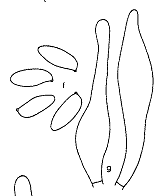
Caption: FIG. 1. Xerocomus nothofagi: f, spores; g, cystidia. | 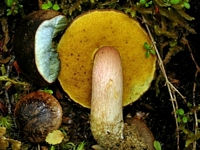
Owner: J.A. Cooper | 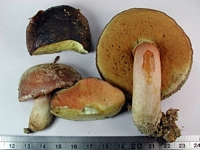
Owner: J.A. Cooper | 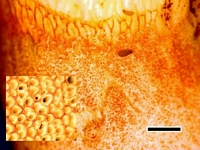
Caption: scale = 2mm. Apex of stem showing carmine glandulae. Insert showing carmine-edged yellow pores.
Owner: J.A. Cooper | 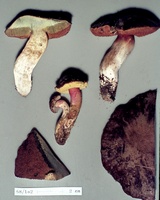
Caption: ZT68-102
Owner: E. Horak: © Creative Commons Attribution-Noncommercial 3.0 New Zealand | 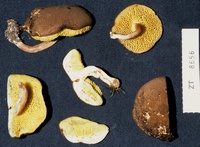
Caption: ZT8656
Owner: E. Horak: © Creative Commons Attribution-Noncommercial 3.0 New Zealand |
Article: McNabb, R.F.R. (1968). The Boletaceae of New Zealand. New Zealand Journal of Botany 6(2): 137-176 (http://www.rsnz.org/publish/abstracts.php).
Description: PILEUS: convex
when young, becoming plano-convex to applanate at maturity, 5-9 cm diam., dry,
finely felted to subtomentose, deep reddish brown, cinnamon brown or cocoa brown,
occasionally light brown, sometimes irregularly creviced near margin when old;
cuticle a trichodermium, composed of erect, branched, septate hyphae 5-8.5 µm.
diam., terminal cells with irregularly thickened walls and brownish contents,
becoming disorganised at maturity; margin entire, often extending beyond pores,
sterile. HYMENOPHORE: tubes to 7mm long, excavated around apex of stipe or occasionally
adnate, dull yellow brown at maturity; pores dull carmine, angular, 0.5-1 mm
diam.; staining faint greenish blue where damaged. STIPE: 3.5-6 cm long, more
or less equal, 1.5-2.5 cm diam., solid when young, often stuffed at maturity,
dry, finely granular to furfuraceous by aggregation of caulocystidia, sordid
white to brownish white, brownish basally, with pink to carmine granulae concentrated
on upper two thirds of stipe; flesh sordid white to pallid yellow, becoming
faintly greenish blue on exposure to air; annulus absent.
SPORES: spore print
not obtained; spores melleous, elliptic-subfusiform, broadly elliptical. or
occasionally obovate, 9.7-13-(16) X 3.9-5.2-(6.5) µm, smooth. HYMENIUM: basidia
hyaline, clavate, 23-32 X 9-11.5 µm, 4-spored, cystidia sparse, scattered, hyaline,
thin-walled, subcylindrical to ventricose-rostrate, 35-48 X 6.2-9.5 µm. HYMENOPHORAL
TRAMA: bilateral, of the Phylloporus subtype, containing oleiferous hyphae
to 10 µm. diam.; clamp connections absent. CONTEXT OF PILEUS: sordid white to
pallid yellow, becoming faintly bluish green on exposure to air. TASTE AND SMELL:
not distinctive. CHEMICAL REACTIONS: KOH and NH4OH on pileus and context of
pileus—no definite reaction.
Habitat: HABITAT: Solitary, gregarious, or caespitose under Nothofagus.
Notes: The elongate spores
and absence of ammonia reaction of fresh pilei indicate that Xerocomus nothofagi
belongs in sect. Xerocomus. The collection of the species under Nothofagus
in three widely separated localities suggests that Xerocomus nothofagi
may form mycorrhizal associations with members of this genus.
X. nothofagi may be distinguished from other Xerocomus species occurring in New Zealand
by the relatively large fruitbodies, dull carmine pores, and apically concentrated
pink to carmine granulae on the stipe.
Article: Gadgil, P.D. (in association with Dick, M.A.; Hood, I.A.; Pennycook, S.R.) (2005). Fungi on trees and shrubs in New Zealand. Fungi of New Zealand. Ngā Harore o Aotearoa 4: xi + 437 p. Hong Kong: Fungal Diversity Press.
Description: Type: Mycorrhizal Fungi; Description: Basidiomata pileate. Pileus deep reddish brown to cinnamon brown, 50–90 mm in diameter, convex becoming applanate, felted to finely tomentose, dry; flesh dirty white to yellowish. Pore surface excavated around apex of stipe; tubes yellowish brown, up to 7 mm long; pores carmine, angular, 0.5–1 mm in diameter. Stipe more or less cylindrical, dirty white to brownish white with pink to carmine granulae concentrated on the upper two-thirds of stipe, finely granular, annulus absent, 35–60 mm long. Basidiospores elliptical, 0-septate, 9–13 × 4–6 μm, smooth, pale yellow.
Distribution: Distribution: Nelson, Buller, Southland.; 1st Record: McNabb (1968).
|